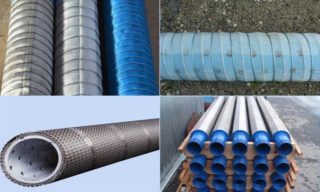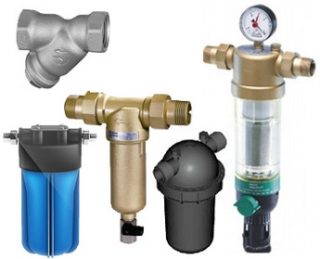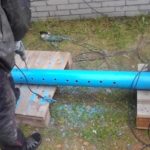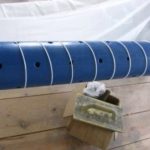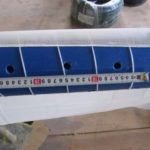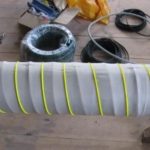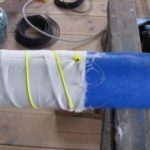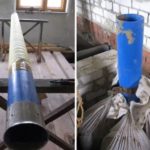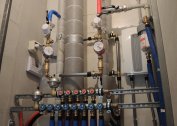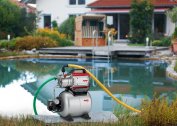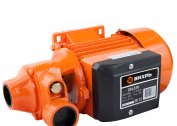Most owners of country houses build an autonomous water supply system in their personal plot, which, undoubtedly, has many advantages. But its content is troublesome. Clogging of well water with clay, silt, sand and other third-party impurities is not uncommon. Only filters will help to solve the problem.
How to choose water filters from a well for cleaning lime and sand
Filters for lime water from a well are divided into several types, so before buying, you should familiarize yourself with the features of each type and selection criteria. Drinking contaminated liquid is unpleasant and dangerous for the human body. To ensure that the well fluid always remains clean, and the water supply system does not become clogged and does not fail, it is necessary to install cleaning filters. One of the first signs by which cleaning devices are distinguished is the place of their installation:
- On the surface they put models that cope only with small debris.
- Modifications are designed inside the casing, designed for rough cleaning - removal of large particles.
To achieve maximum results, it is recommended to equip the water supply system with two types of filters at once. A third device is also installed near the water tap, the main task of which is to clean the liquid from nitrates, iron and other foreign impurities.
All the simplest models of purification filters are designed to remove clay, sand and silt impurities from water. As a rule, stainless steel is used to make the mesh. The grid cell sizes range from 0.12-3 mm.kv. Quite often, such filters are additionally equipped with several layers of mesh with holes of various shapes. Technical features of devices:
- Reasonable cost and subject to operating rules a long service life.
- Quickly and easily removed for replacement.
- Reduce the performance of the source, due to the presence of metal resistance and cell frequency.
- They quickly fail when used in wells with a high concentration of iron.
The first advantage of slot and hole devices is their compact size, they look like a pipe with a large number of holes. Features of such designs:
- Mounted in soil, which contains a high concentration of gravel, gravel and pebbles.
- Designed to purify water from artesian wells.
- Sand with a diameter of up to 2 mm and large particles up to 1 cm in size are detained.
- The cleaning system is characterized by ease of installation and durability.
- The soil, which contains a large amount of impurities, sand, etc., quickly clogs holes, so regular preventive washing is required.
Experts recommend purchasing hole and slot filters, additionally equipped with stiffeners, this will prevent possible deformation.
Wire varieties consist of a body and a pipe with holes, as well as a sump. Features of such designs:
- They are installed in casing strings to purify water from artesian and sand wells.
- Some models are not repairable.
- Often there are difficulties in cleaning the holes when they are dirty.
- Long life, high performance.
Gravel filters are intended for additional clarification of liquid. Installation is simple - sprinkle gravel and sand on the surface of the well.
There are filters for water, the task of which is to disinfect the liquid. These include reverse osmosis systems, ion-exchange and ultraviolet installations.
Installation of water treatment plants

For the first stage of purification of water from a source, hole or slotted cleaning structures at home are most often used. Their advantages are high work efficiency and ease of execution, installation. Installation Algorithm:
- Prepare all work equipment. You will need a pipe made of stainless steel or plastic, a mesh of stainless steel or brass, equipped with small cells, a wood cork and a drill with a drill. The diameter of the pipe should be less than the diameter of the casing, the length depends on the depth of the water mirror, but not more than 5 meters.
- A minimum of 10 cm section should be measured on the pipe. This is necessary for the construction of a sump.
- Just above the area for the sump, marking is made for the hole part. The holes are placed strictly in a checkerboard pattern, the interval between them varies between 1-3 cm. The more holes on the canvas, the higher the throughput of the cleaning system.
- In the direction from the bottom up at an angle up to 60 degrees holes are drilled.
- All dirt and shavings are removed, the hole section is stretched with a mesh. It is fixed with rivets.
- On the sump side, the tube is closed with a wooden stopper.
When installing a water purification system, you need to know that the hole zone should occupy at least ¼ of the total length of the pipe.
How to make a filter yourself
Before proceeding with the manufacture of a cleaning filter with your own hands, you need to determine which cell sizes will be most optimal. This is calculated by trial and error. Fine particles of sand, silt are sifted through the options that have attracted you. Preference should be given to one that has retained at least 50% of the pollution.
Next, you need to make a case. For this, a wire is wound with a spiral with an interval of 2-3 cm. Using a special soldering iron, it is possible to fasten the case. From the top in a single layer wrap the mesh. Fasten with a special adhesive or welding.
If the task is to make a gravel system with your own hands, at the initial stage you need to select the gravel of optimal size. As a rule, in its mass, it should several times exceed the mass of mechanical debris contained in well water. During the manufacture of the system, a bag of cargo must be lowered into the bottom extension. After that, tamping, pour gravel into it.
- 1. Punching a pipe
- 2. Winding aluminum wire
- 3. Mount synthetic mesh
- 4. Wire mesh winding
- 5. Fixation of the wire with screws
- 6. Fixation of the column with bags of soil
It is already much more difficult to make a wire type of device yourself. In this case, it will be more profitable to purchase a filter of the required diameter and fix it on the hole section of the previously prepared pipe.
For self-installation of any type of cleaning filter, it is important, first of all, to determine its throughput. If a person is not sure that he will be able to perform all the work qualitatively, it is better to entrust it to specialists. As practice shows, excessive savings lead to large waste.
